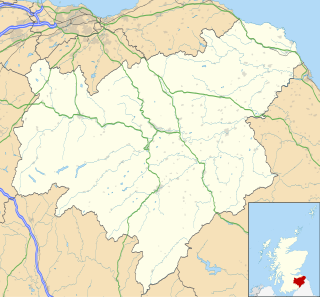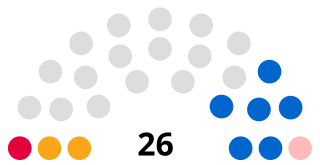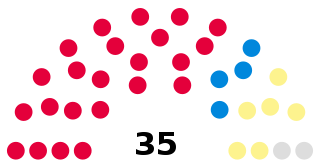
The Scottish Borders is one of 32 council areas of Scotland. It is bordered by West Lothian, Edinburgh, Midlothian, and East Lothian to the north, the North Sea to the east, Dumfries and Galloway to the south-west, South Lanarkshire to the west, and the English ceremonial counties of Cumbria and Northumberland to the south. The largest settlement is Galashiels, and the administrative centre is Newtown St Boswells.

The 1995 Highland Council election was held on 6 April 1995; the same day as elections to the 28 other new councils in Scotland. 72 councillors were elected from 72 wards using the first-past-the-post voting system. Independent councillors retained their status as the majority group, with councillors also being elected representing the Conservative Party, Labour Party, Liberal Democrats, and Scottish National Party. The newly elected council existed in 'shadow' form until it assumed its full powers on 1 April 1996.

The 1994 United Kingdom local elections were held on Thursday 5 May 1994. The results showed a continued decline for the governing Conservatives — who were now in their 15th successive year of government at Westminster — with the third-placed party, the Liberal Democrats, as the main beneficiaries.

The 1994 Scottish regional elections were held in Scotland on 5 May 1994, as part of the Local Government (Scotland) Act 1973. These were the last elections before 29 new mainland unitary authorities, established by the Local Government etc. (Scotland) Act 1994, came into effect. The councils up for election were last contested in 1990 Scottish regional elections, and vote and seat changes are compared to the 1990 results.

Local elections were held in Scotland on 7 May 1992, to elect members to all 53 district councils. It was the last local election held under the Local Government (Scotland) Act 1973, which had established the two-tier system of regions and districts. Regional and district councils were abolished in 1996, and replaced with 29 new mainland unitary authorities under the terms of the Local Government etc. (Scotland) Act 1994.

Elections to Strathclyde Regional Council were held on Thursday 5 May 1994, on the same day as the eight other Scottish regional elections. This was the final election to the regional council which was abolished in 1995 along with the 19 district councils and replaced by 12 unitary authorities following the implementation of the Local Government etc. (Scotland) Act 1994.
The sixth and last election to Tayside Regional Council was held on 5 May 1994 as part of the wider 1994 Scottish regional elections. The election saw the Scottish National Party overtaking Labour to become the council's largest party, and following the election the SNP formed a minority administration. The Conservatives lost 10 seats and became the third largest party. 8 weeks later, leader of the council Lena Graham resigned 'for personal reasons' and Ewan Dow took over as council leader.

Elections to the Shetland Islands Council were held on 5 May 1994 as part of Scottish regional elections. The Shetland Movement lost one but maintained six seats, while the Liberal Democrats gained representation on the council for the first time. Only ten seats were contested.

The 1994 Fife Regional Council election, the sixth and final election to Fife Regional Council, was held on 5 May 1994 as part of the wider 1994 Scottish regional elections. The election saw Labour maintaining their control of the region's 46 seat council.

The sixth election to Western Isles Islands Council was held on 5 May 1994 as part of the wider 1994 Scottish regional elections. One ward - Laxdale - was unfilled, as no individuals came forward as candidates.

The 1994 Central Regional Council election, the sixth and final election to Central Regional Council, was held on 5 May 1994 as part of the wider 1994 Scottish regional elections. The election saw Labour hold their overall majority, taking 23 out of the 35 available seats.

The 1994 Dumfries and Galloway Regional Council election, the sixth and final election to Dumfries and Galloway Regional Council, was held on 5 May 1994 as part of the wider 1994 Scottish regional elections. The election saw Independents take the most seats, although they lost their overall majority.

The 1994 Grampian Regional Council election, the sixth and final election to Grampian Regional Council, was held on 5 May 1994 as part of the wider 1994 Scottish regional elections. The election saw the Liberal Democrats take the most seats, although the Scottish National Party had a higher number of votes. No party gained an overall majority.

The 1994 Orkney Islands Council election, the sixth election to Orkney Islands Council, was held on 5 May 1994 as part of the wider 1994 Scottish regional elections. The election saw Independent candidates take all seats available, except for the ward of Kirkwall Pickaquoy, which had no nominations.

Elections to Cumnock and Doon Valley District Council were held on 7 May 1992, on the same day as the other Scottish local government elections. This was the final election to the district council which was abolished in 1995 along with Kilmarnock and Loudoun District Council and replaced by East Ayrshire Council following the implementation of the Local Government etc. (Scotland) Act 1994. The regional council, Strathclyde was also abolished and the new unitary authority took on its responsibilities.

Elections to East Kilbride District Council were held on 7 May 1992, on the same day as the other Scottish local government elections. This was the final election to the district council which was abolished in 1995 along with Hamilton District Council and Clydesdale District Council and, combined with part of the abolished City of Glasgow District Council, was replaced by South Lanarkshire Council following the implementation of the Local Government etc. (Scotland) Act 1994. The regional council, Strathclyde, was also abolished and the new unitary authority took on its responsibilities.

Elections to Kilmarnock and Loudoun District Council were held on 7 May 1992, on the same day as the other Scottish local government elections. This was the final election to the district council which was abolished in 1995 along with Cumnock and Doon Valley District Council and was replaced by East Ayrshire Council following the implementation of the Local Government etc. (Scotland) Act 1994. The regional council, Strathclyde was also abolished and the new unitary authority took on its responsibilities.
The first elections to South Lanarkshire Council were held on 6 April 1995, on the same day as the 28 other Scottish local government elections. The council was created from the former Clydesdale, East Kilbride and Hamilton district councils plus the four wards of the City of Glasgow District Council in Rutherglen and Cambuslang and assumed some of the responsibilities of the former Strathclyde Regional Council following the implementation of the Local Government etc. (Scotland) Act 1994.

The 1990 Borders Regional Council election, the fifth election to Borders Regional Council, was held on 3 May 1990 as part of the wider 1990 Scottish regional elections. The election saw the Independents win a majority on the 23 seat council.
The first elections to East Ayrshire Council were held on 6 April 1995, on the same day as the 28 other Scottish local government elections. The council was created from the former Cumnock and Doon Valley and Kilmarnock and Loudoun district councils and assumed some of the responsibilities of the former Strathclyde Regional Council following the implementation of the Local Government etc. (Scotland) Act 1994.

















